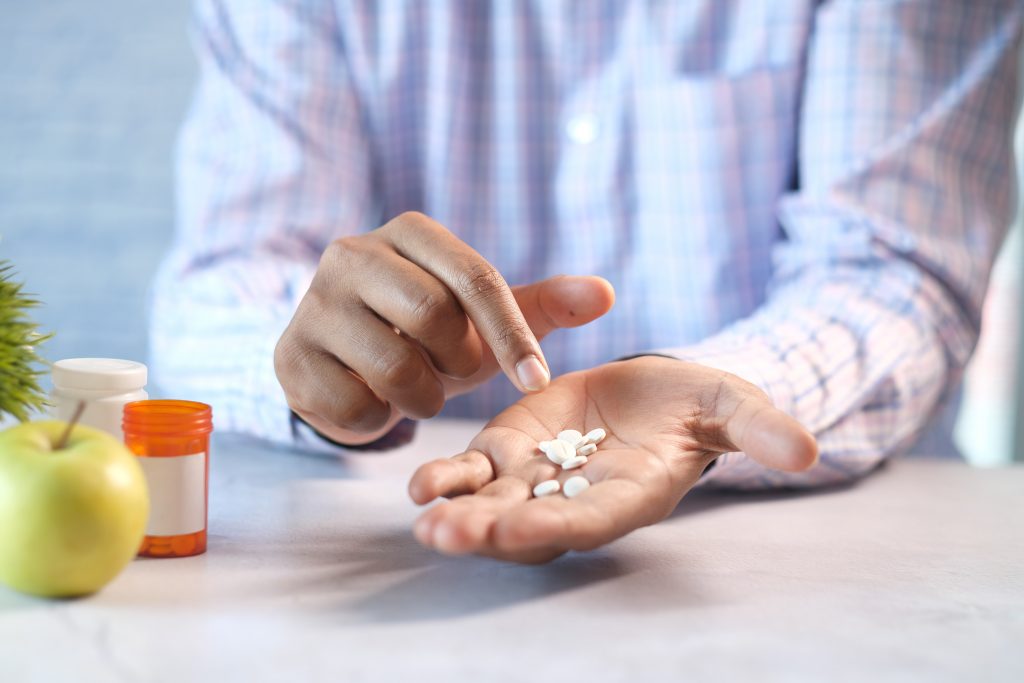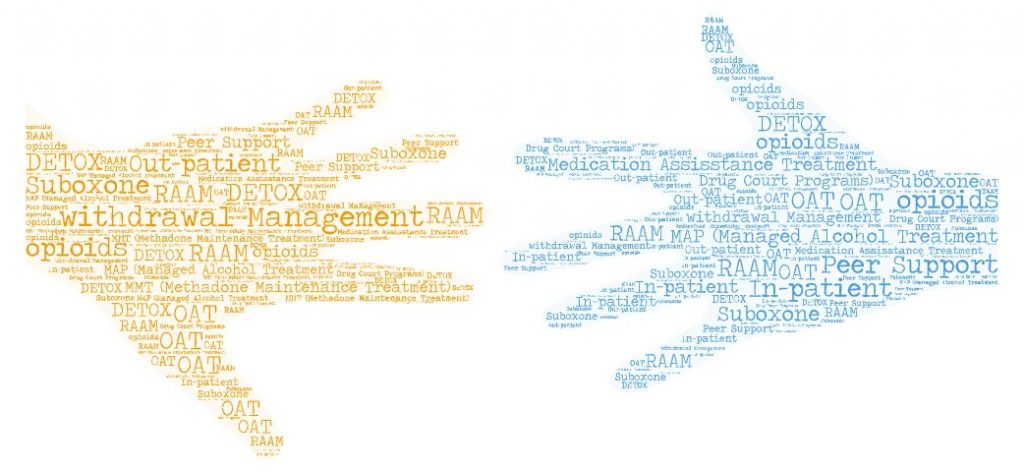4.7 Withdrawal Management, Overdose Prevention & Harm Reduction
Withdrawal Management Programs

In this chapter we examine the challenge & barriers around the diversity in the variety of Withdrawal Management Programs that include RAAM clinics, OAT (Opioid Agonist Treatment) / MMT (Methadone Maintenance Treatment) including Suboxone, MAP (Managed Alcohol Prevention) and Peer Supports.
Rapid Access to Addictions Medicine (RAAM) Clinics
The RAAM Clinic is an easy to access walk-in/drop-in clinic that people can visit to get help for substance use without an appointment or formal referral. RAAM Clinics are attached to hospitals and have a multi-disciplinary team. RAAM Clinics are situated in most provinces across Canada. Services are provided on a first come, first served basis, with some prioritization by clinic staff based on urgency. Contact the closest clinic to find out what their hours and days are.
What is a RAAM clinic and who is it for?
RAAM clinics are for:
- people looking to get help with high risk substance use and addictions
- interested in trying medical assistance to reduce or stop their substance use
- experience frequent intoxication or overdose symptoms, as well as unpleasant withdrawal symptoms when attempting to reduce or stop their substance use
- people who have substance-related health issues, such as hepatitis, pancreatitis, or infections, among others..
RAAM clinics are not for people who:
- need urgent medical attention for urgent physical problems or mental health symptoms such as psychosis (paranoia, delusions, hallucinations) or agitation
- active risk of harm to self or others
- requiring police/security involvement.
The people working at these clinics know how difficult it is to ask for help. You don’t need an appointment to go to the clinic – just show up during clinic hours with your Health card.
It is that medical treatment for problematic substance use is safe and effective.
What happens when you go to a RAAM clinic?

The clinic team will ask you about your history of substance use:
- when and how you started using
- how much and how frequently you use
- how it may impact your life and responsibilities
The RAAM clinic team then recommends what treatment will likely work best for you. There are four options:
- Advice – Many people who have to go to the hospital for a substance-related problem are injured as a result of using too much. In these cases, the RAAM clinic team will provide you with advice on how to make choices that will minimize the risks of substance use, such as tips on how to pace your use and situations to avoid.
- Counselling – The RAAM clinic team may refer you to counselling as part of your treatment. Counselling programs can include education on substances and healthy lifestyle choice, group and individual therapy sessions, help with developing coping skills, cognitive behavioural therapy, and peer support groups. The team will work with you to determine what form of counselling would be most helpful for you.
- Medications – Addiction to some substances, such as alcohol or opioids, can be treated with a medication that will help to lessen cravings, as well as the withdrawal symptoms that may accompany your early days of sobriety. Medication usually makes other types of treatment much more effective and reduces the risk of relapse. These medications are safe, effective, and non-addictive. The team will discuss your options with you.
- Support – If you’re feeling anxious or hesitant about going to the RAAM clinic, consider bringing a supportive person with you. Changing your substance use can be very difficult, and having someone with you while you speak to the team may make you feel less overwhelmed and less alone.

IMPORTANT – If you are seeking treatment for opioid addiction, abstinence (including withdrawal management/detoxification) is NOT recommended. Opioid Agonist Treatment (OAT) (the use of long-acting medications to treat withdrawal and prevent relapse) is recommended as a safe and effective way to treat your opioid addiction.
When you begin your recovery from opioid addiction, abstinence can place you at higher risk of overdose, medical harms and death. You are welcome to attend a RAAM clinic or contact other OAT providers to discuss your options.
YOU SHOULD KNOW
Individuals do not have to be substance-free for any length of time to access RAAM services. However, they must be able to have an informed conversation about treatment, understanding the risks and benefits of treatment options. If a person is too intoxicated to have an informed conversation, they may be asked to return at a later date or referred to another community service.
If an individual with opioid use disorder is to receive Opioid Agonist Treatment (OAT) with buprenorphine/naloxone (Suboxone), the time from last opioid use will factor into the decision on how to safely start the medication.There is no specific timeframe of required abstinence from opioids before attending RAAM
OPIOID AGONIST THERAPY (OAT)

How does Opioid Agonist Therapy (OAT) Work?
(OAT) is an effective treatment for addiction to opioid drugs such as heroin, oxycodone, hydromorphone (Dilaudid), fentanyl and Percocet. The therapy involves taking the opioid agonists methadone (Methadose) or buprenorphine (Suboxone). These medications work to prevent withdrawal and reduce cravings for opioid drugs. People who are addicted to opioid drugs can take OAT to help stabilize their lives and to reduce the harms related to their drug use
When a person is addicted to shorter-acting opioids, a long-acting opioid (methadone and buprenorphine) are used. The long-acting means that the drug works for a longer period of time by acting more slowly in the body. This prevents withdrawal for 24 to 36 hours without causing a person to get high. OAT reduces or eliminate cravings for opioid drugs. When combined with support, such as individual or group counselling, there are best outcomes.
Usage of opiates in Canada is being called a public health crisis by both advocates of substance use treatment programs (Canadian Centre on Substance Use and Addiction, 2021) and the Government of Canada (2021b). The Government has recognized this crisis has only worsened during the Covid-19 pandemic. Many urban and rural communities across Canada have reported a record number of opioid-related deaths, emergency calls and hospitalizations (Government of Canada, 2021b). While medications like medical grade heroin and hydromorphone can treat opiate use disorders, there are other medications that have also positively impacted the lives of people who use opiates.
More Information:
MMT (Methadone Maintenance Treatment)

Methadone is a medication primarily used to treat chronic pain and as a treatment for opioid use disorder. It is a controlled substance that is regulated under the Controlled Drugs and Substances Act (CDSA), and the Narcotic Control Regulations (NCR).
In the past, practitioners were required to obtain an exemption from Health Canada before they could prescribe, sell, provide or administer methadone.
Methadone is a long-acting opiate, which is substituted for short acting opiates like fentanyl, Percocet, oxycodone, and heroin (Centre for Addiction and Mental Health, 2021b). This type of OAT manages the withdrawal symptoms a person experiences as withdrawal from opiates can be physically painful. It can also be emotionally distressing, particularly if the substance is being used as a coping tool. Evidence from research around the globe has demonstrated that methadone is an effective treatment; it can help people with an opioid addiction in more ways than one (Centre for Addiction and Mental Health, 2021).
Suboxone (Buprenorphine/Naloxone)

Buprenorphine/naloxone, sold under the brand name Suboxone among others, is a fixed-dose combination medication that includes buprenorphine and naloxone. It is used to treat opioid use disorder, and reduces the mortality of opioid use disorder by 50%. It relieves cravings to use and withdrawal symptoms.
Is Suboxone legal in Canada?
Health Canada has authorized 2 dosage forms of SUBOXONE (buprenorphine and naloxone), a sublingual tablet and soluble film, that are not bioequivalent at all doses and routes of administration.
Important Information:
MAP (Managed Alcohol Prevention)

The MAP Program originally was considered withdrawal management but is now considered a Harm Reduction model. Originally when MAP were created it was to be harm reduction. It was quite controversial and created polarized views on the reasoning for such a program. The goal was to support an individual where they were at on the substance use continuum. It was important to assist with the withdrawals of Alcohol as one of the most widely used substances in Canada; alcohol use is on a spectrum.
MAPs have become an important part of harm reduction in Canada. Click here for a list of MAP sites in Canada (Canadian Institute for Substance Use Research, 2021).
This documentary by CBC highlights some of the individuals who utilize MAPs as well as the healthcare and shelter staff who support these individuals. Please click here to watch The Pour (CBC, 2016).
Withdrawal Management (Detoxification)
All substances have an impact on the body and the brain. Some substances like alcohol have such a strong impact that they can cause death. Alcohol withdrawal requires medical intervention when a person wants to slow down or stop. This service is often referred to as detoxification (detox); however, today we use the term withdrawal management. This can be inpatient or outpatient.
Activities:
- Other words associated with substance use disorders have stigma. When you hear detoxification or detox, what do you think of?
- Compare the terms detoxification and withdrawal management. Why do you think this has changed?
- Is withdrawal management clear? Do you think language matters in this case? Why or why not?
- Click on this link to an alcohol screening guideline in British Columbia. Notice the language.
- Would you change the term “problem drinking”? Why or why not?
You may think of a broader health perspective than substance use when you hear the word detoxification; in this context, detoxification or the preferred term, withdrawal management, is a medically assisted/managed program. Medications and devices can be used to manage withdrawal symptoms, prevent relapse, and treat co-occurring conditions. Withdrawal management is not in itself “treatment,” but only the first step in the treatment process.
In-Patient Withdrawal Management

If a person has access to a provincial health card, in-patient withdrawal management may be referred by a health care provider, or it may also be self-referred. If people have the financial means, they may pay privately or access funds through an insurance provider for private in-patient withdrawal management at a private facility. Regardless of public or private, all individuals are screened to see if they meet the criteria for in-patient withdrawal management. It is important to note that screening is not diagnosing, screening is a tool to determine which service an individual may benefit from, based on their substance use. Screening may highlight some of the areas of intersectionality of substance use. In-patient withdrawal management is provided by all provincial health care services. It is important to note that health providers utilize different screening tools to determine suitability for all treatment services, not least of which is in-patient withdrawal management.
Food For Thought:
- Are in-patient withdrawal management available for every substance?
- Where are the in-patient withdrawal management centres in all provinces and territories?
- Is out of province for in-patient withdrawal management possible?
- Why do you think someone would leave their province to go to treatment?
- What are the challenges with accessing in-patient withdrawal management?
- Is in-patient withdrawal management available to everyone? If not, who might be excluded?
- What happens after in-patient withdrawal management?
- When you think about intersectionality of substance use, does in-patient withdrawal management address all the concerns? Are there barriers people could face in a hospital setting?
- Does in-patient withdrawal management impact all genders equally? What concerns might women bring with them to in-patient withdrawal management?
- Does in-patient withdrawal management support people of all races and cultures?
- When you think about the social determinants of health, does in-patient withdrawal management address all the concerns?
- How would you find out if there a wait list for any in-patient withdrawal management in any province or territory?
In-patient withdrawal management is an important component of treatment, particularly for substances that are life threatening to withdraw from, like alcohol. Substances like opioids are painful to withdraw from, in which case some individuals may be prescribed opiate replacement therapy, including methadone or buprenorphine, which we will discuss below.
In-patient treatment is also offered by many privately owned facilities in many provinces and territories. Imagine spending days and nights in a beautiful facility with private doctors, registered nurses, and counsellors, all for the cost of approximately $600/day+. Some insurance companies cover the costs of private treatment; however, for those without private health insurance, treatment facilities like these may be out of reach.
Activities:
- Compare and contrast a program at a private facility with a provincially funded program.
- Are privately owned facilities allowed in Canada?
- Who licenses these facilities?
- What does the presence of private clinics indicate about healthcare?
Outpatient Withdrawal Management
Along with in-patient withdrawal management, people living in any province will need a health card may have access to out-patient withdrawal management. This program “combines functions of an outpatient (day program) withdrawal management (detox) and structured treatment, providing the support of a team-based approach” .
Food For Thought:
- Why do you think someone might choose out-patient withdrawal management instead of in-patient? Think about intersectionality and the social determinants of health.
- What is the difference between the two?
Outpatient Treatment
For people who have completed a withdrawal management program, this is often not the end of their journey; it may be just the beginning. In many provinces and territories, options exist for people who are choosing to engage with a health care provider about their substance use. Each Health Authority provides a variety of outpatient treatment programs in various locations, from two-week full day programs to weekly appointments. Each province and territory have many different options.
Medication Assisted Treatment (HAT – Heroin Assisted Treatment)
When we talk about using medication to treat substance use disorders, some people suggest it is not different, that in fact we are swapping one substance for another. This is a myth. For some individuals, using a different medication or a similar medication may reduce some of the harms of the substance. The Providence Health Clinic in Vancouver recognized that the continued use of heroin can be fatal if not treated (McLellan et al., 2000) and began working with a small number of individuals who had an opiate use disorder. They developed SALOME, a prescribed heroin project or heroin assisted treatment (HAT). SALOME developed out of the NAOMI project, North America’s first HAT program, an initiative between the US and Canada in the 1990’s (Garty et al., 2009). These projects were breaking new ground as well as challenging ideologies about substance use. Both NAOMI and SALOME were challenged by previous federal Governments; however, the Providence Health Clinic challenged those decisions and became the only clinic in North America to “provide medical grade heroin and hydromorphone within a supervised clinical setting to chronic substance use patients” (Providence Health Clinic, 2021, para. 1).
(Providence Health Vancouver, 2016).
This approach to treating substance use allowed individuals, in partnership with their healthcare provider, to manage their substance use like a chronic illness. For some, this was a novel approach to treating substance use; for others, it was a clear example of how programs based on a public health approach can change/save lives.
Food For Thought:
- Take a moment and think about how you feel about treating heroin use with medical-grade heroin.
- What does the evidence say about the safety and effectiveness of medication assisted treatment?
- What do you want to know more about?
- What are some of the challenges with programs like these?
Activities:
- Review the following Centre for Addiction and Mental Health pamphlet on opiate agonist treatment.
- How long can someone use methadone or bupenorphine?
- Are there side effects of these medications?
- What are the positive aspects of OAT? Negative aspects?
- Create a poster for OAT. Include three main facts that you believe would help reduce the stigma of OAT.
Drug Court Programs (DCP)

Many people who use substances are incarcerated. According to the 2017 report on drug offences in Canada, over 95,000 people were charged with various drug offences, many of which were related to cannabis (Boyd, 2017). One way in which Nova Scotia has decided to tackle the issue of incarceration for substance related criminal activity is the creation of a Court Monitored Drug Treatment Program or Drug Court Program (DCP). “In 2015, the Mental Health Court Program partnered with the Nova Scotia Health Authority’s Opioid Treatment Program to introduce the Court Monitored Drug Treatment Program” (The Courts of Nova Scotia, n.d. para. 1). The DCP offers “alternative criminal sentences for people charged with crimes directly related to their opioid addiction” (para. 1).
Drug Courts began in the United States, who were dealing with an unprecedented epidemic of substance use and incarceration as part of the war on drugs. To deal with the issues facing the criminal justice system, DCP’s were born, which began to recognize the role of intersectionality in substance use and provided “expedited case processing, outpatient treatment, and support services (e.g., job placement and housing)” (Lurigio, 2008, p. 13). Canada adopted its first drug court program in Toronto in 1998 (Government of Canada, 2021a). The programs have evolved, but the focus is still the reduction of the number of individuals incarcerated for substance related crimes and addressing the substance use disorder as the main issue, rather than the crime itself. DCP’s focus on access to treatment for offenders who meet criteria and provide an alternative to incarceration by offering an opportunity to complete a substance use treatment program (Government of Canada, 2021a). The data on DCP’s is quite promising. Regardless of the recidivism rates of the individuals who participated in a DCP, “the majority of them had achieved some quality-of-life improvements (e.g., no longer homeless, received several months of addiction treatment and were connected to social supports within the community)” (Government of Canada, 2021a, para. 18).
PEER SUPPORT

Who is on your team? What is a friend? It is important to know who is on your team as a peer, friend, professional and knowing what their role actually is. It can be someone you can count on or trust to talk about problems or a bad day. Peer support builds on the concept of friendship, but a peer supporter is different than a friend. “Peer support can be defined as the process of giving and receiving nonprofessional, nonclinical assistance from individuals with similar conditions or circumstances to achieve long-term recovery from psychiatric, alcohol, and/or other drug-related problems” (Tracy & Wallace, 2016, p. 165).
Peer support is a multi-faceted system within the field of substance use with varying opinions and efficacy. Peer support plays a role at all stages of substance use. It can happen with individuals starting their substance use and can move through all the way to recovery; there is significant value in peer support among individuals who use substances (Tracy et al., 2016, Boisvert et al., 2008, Kelly et al., 2017).
Informal peer support may take place in a situation where someone who uses substances is increasing their use and injecting for the first time. They may be guided by someone who knows how to inject properly and safely, offering clean supplies and ensuring the person tests their substance and does not use too much, putting them at risk of overdose. This is called informal peer support, peer helping or natural helping. Peer helpers try to dissuade people from starting to inject, act as first responders for overdoses, test drug potency, administer first aid, share prescription drugs such as antibiotics, offer temporary housing, counsel on emotional/psychological issues, and support those who are striving to reduce their drug consumption. (Dechman, 2015, p. 497)
In Vancouver, the Vancouver Area Network of Drug Users (VANDU) emerged in 1997, the first drug users union in Canada. This group secured a permanent site in 1997 and began offering support, education, and advocacy for group members. They advocated for safe injection supplies and saw the creation of Insite, Canada’s first safe injection site in 2003. They have provided informal peer support to individuals for over 24 years and continue to do so today (Vancouver Area Network of Drug Users, 2016).
Peer Support available:
- AA – Alcoholics Anonymous
- Active Aging Canada
- Aids Groups
- Al-anon – people caring about family/friends who are alcoholic
- Ala-teen -is a peer support group for teens who are struggling with the effects of someone else’s problem drinking
- ACA – Adult Children of Alcoholics
- any 12 step programs (can look up local meetings)
- Celebrate Recovery
- CMHA (Canadian Mental Health Association)
- CA (can look up local meetings)
- CoDA – Co-Dependents Anonymous
- Indigenous Groups
- GA – Gamblers Anonymous
- NA – Narcotics Anonymous
- Racialized peoples and communities
- Refuge Recovery – Buddhist Path to Recovering from Addiction
- 2SLGBTQIA+ peoples and communities
- Youth
- Seniors
Principles of Effective Treatment
The following key principles should form the basis of any effective treatment program:
- Substance use disorders are complex.
- No single treatment is right for everyone.
- People need to have quick access to treatment.
- Effective treatment addresses all of the individuals needs, not just their substance use.
- Staying in treatment long enough is critical.
- Counselling and other behavioural therapies are the most commonly used forms of treatment.
- Medications can be an important part of treatment, especially when combined with behavioural therapies.
- Treatment plans must be reviewed often and modified to fit the individuals changing needs.
- Treatment should address other possible mental health disorders.
- Treatment should address the social determinants of health.
- Medically assisted withdrawal is only the first stage of treatment.
- Substance use during treatment must be monitored continuously, to prevent overdose.
- Treatment programs should encourage individuals to test for HIV, hepatitis B and C, tuberculosis, and other blood borne illnesses as well as sexually transmitted infections if they engage in risky behaviours. This way individuals will have a more complete picture of their health.
- Treatment programs should teach individuals about steps they can take to reduce their risk of these illnesses (harm reduction).
(Schwab, 2021)
For More Information on Withdrawal Management
- Provincial Guidelines for Biopsychosocial Plus Withdrawal Management Services in BC
- Medical Withdrawal Unit – CAMH
- Withdrawal Management Services in Canada: The National Treatment Indicators Report (2015-2016 Data) – CCSA
- Modernizing Withdrawal Management Services – The Canadian Journal of Addiction: June 2021 – Volume 12 – Issue 2 – p 33-38
References:
- Figure 4.7.10 – Halsey, D. (2022, March 29). Peer Support [WordArt].
- CAMH. (n.d.-b). Opioid Agonist Therapy. Retrieved March 26, 2022, from https://www.camh.ca/-/media/files/oat-info-for-clients.pdf
- Shared Health Manitoba. (n.d.). Rapid Access to Addictions Medicine (RAAM) Clinic. Retrieved March 29, 2022, from https://sharedhealthmb.ca/services/mental-health/raam-clinic/

